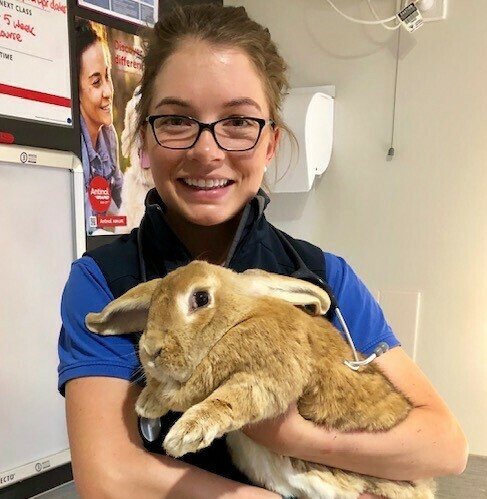| October 2020 Pet Care Newsletter |
|
|
With all its surprises what an amazing spring 2020 is delivering - enticing us to be outside, stretching our legs and enjoying warm days and fresh air with our pets.
We have news this month regarding some vet staff changes & we're excited to share the launch of the OVH Petcare Podcast.
This newsletter we have several articles relating to all things kidney in our pets....if any signs or symptoms seem familiar for your pet make sure to call us for a check up. |
|
|
 |
Genevieve will take maternity leave from Friday 9th October - we know she needs a break from our busy days before baby arrives.
Rest up Genevieve! |
|
 | We are delighted to welcome Georgia Ladmore to our veterinary team - Georgia, an experienced vet from Wagga, will work as a dedicated small animal vet based at our Orange Hospital.
Georgia is currently working Mondays, Tuesdays & alternate Saturdays. She is quickly becoming familiar with our workspace and enjoying meeting our patients and their owners.
We are thrilled to have you join us Georgia. |
|
|
|
 | | OVH Petcare Podcast - caring for Pets across the World | | | Orange Vet Hospital has launched its very own podcast! The Petcare Podcast is all about offering the best care for everyone’s best friend no matter where you live.
Available through your preferred podcast service, the first series of the Petcare Podcast will be published fortnightly offering puppy training tips, vet insights and detailed information on topics chosen by you, the listener!
In episode one, vet Nikki Burns covers the topic of desexing your pet, and you’ll meet one of the newest members of the Orange Vet Hospital team, vet Ryan Lane.
To subscribe to the Petcare Podcast, and hear our first episode, simply click on this link, or search for the Petcare Podcast on your podcast app.
https://anchor.fm/kim-dale/episodes/Pet-desexing--observe-your-pets--puppy-training-tips-eke0st |
|
|
 | | What is kidney disease? | | | Just like humans, our pets have kidneys too. The role of the kidneys is to filter out waste from the blood to produce urine, together with playing an important role in maintaining the balance of fluids and electrolytes within the body, the kidneys produce hormones and enzymes that help regulate various metabolic functions throughout the body. When there is a problem with any aspect of the kidneys function, this is referred to as kidney disease or renal failure.
Signs of kidney disease
Because the kidneys play such a vital role in filtering waste products from the blood, if this process is not working correctly then your pet can become sick due to the build-up of toxic waste products in the blood which would normally have been excreted out of the body via the urine. Kidney disease can be caused by infections, traumatic injuries, exposure to toxins, dehydration and heatstroke. Kidney disease can also occur more commonly in older pets.
The signs of kidney disease can include:
- Increased thirst and urination
- Reduced appetite and weight loss
- Bad breath
- Vomiting and diarrhoea
Diagnosis and treatment
If we suspect that your pet may be suffering from kidney disease, then it is common to consider performing a urine test and a blood test which can measure different enzymes and substances in the blood and urine to determine if the kidneys are functioning normally. Further diagnostic tests may often also be indicated, including imaging (x-rays or ultrasound), blood pressure measurement and further blood tests. Treatment for kidney disease will vary depending on the cause and severity of the illness, but we will be able to advise you on what is involved in your pet’s case and how it will help. |
|
|
 | | Bladder stones and obstructions | | | Bladder stones are rock-like accumulations of minerals which can form in the bladder. The bladder stones can occur as a few larger stones or multiple smaller stones. The smaller stones can sometimes block the urethra, which is the outflow tube from the bladder, causing pain or difficulty with urination.
Signs of bladder stones
Depending on the size and number of stones that form in the bladder, sometimes pets do not show any signs of having them. In other cases, the presence of bladder stones can cause blood-tinged urine, difficulty urinating and increased frequency of urination. If the stones are blocking the urethra preventing urination, this can quickly become painful for the pet, and they may appear lethargic, lose their appetite and can often vomit.
If the bladder cannot empty urine, not only is this painful for the pet, but the toxic products that are normally excreted out of the body in urine, build up in the bloodstream and can result in kidney damage and other problems. A blocked bladder is also at risk of rupturing, where urine can leak into the abdominal cavity causing disease.
Why do bladder stones form?
There are a variety of causes which can contribute to the formation of bladder stones, including high blood levels of particular minerals, changes in the acidity of the urine, bacterial infections and abnormal metabolism of various minerals, which can occur in specific dog breeds such as Dalmatians.
Depending on their size, number and location, bladder stones can often be diagnosed via a combination of physical examination, urine tests and imaging (x-rays). Treatment of bladder stones will vary depending on the size of the stones and the type of mineral which has formed them. Larger bladder stones in the bladder can be removed surgically, and pets with urethral obstruction will require surgery or other procedures under anaesthesia to flush the urethra. There are also special urinary diets which we may recommend to help dissolve and prevent bladder stones forming. |
|
|
 | | How urine tests can help us diagnose disease | | | A urine test is a simple and effective method for us to check the health of your pet’s urinary system. The process involves collecting a urine sample from your pet, which can then be tested within the clinic or sent to a pathology laboratory for analysis. If you notice a change in your pet’s urine, such as discoloured urine then you could try to collect a urine sample to bring into the clinic for testing. Alternatively, we may ask you to collect a urine sample from your pet to aid in the diagnosis of particular diseases.
How to collect a urine sample
With dogs, collecting a urine sample is usually a matter of waiting until they go to urinate, and then catching a sample of the urine into a clean and dry container such as a plastic bowl or jar. Once the sample is collected, you can bring it into the vet hospital for testing.
For cats, collecting a urine sample can be a bit trickier. If your cat uses a plastic litter tray, you can remove the cat litter and replace it with shredded bubble wrap, and then when the cat urinates you can tip a small amount of urine from the tray into a clean plastic container.
If you’re unable to collect a urine sample from your cat, then you can organise to bring them into the clinic. We can often palpate and express a cat’s bladder to collect a urine sample. If this is not possible, we may consider using a technique called cystocentesis, which involves collecting a urine sample from the bladder by passing a needle through the abdomen – we can explain this procedure in more detail if it is recommended.
The benefit of testing your pet’s urine is that it provides us with a large amount of information on the health of your pet’s urinary system. Urine tests can be helpful in assessing for conditions such as urinary tract infections, kidney disease, diabetes, bladder stones and other metabolic conditions. |
|
|
 | Vet Nickala with Sebastian the Rabbit visiting for his annual vaccination
Zoetis, suppliers of Cylap RCD vaccine for rabbits, have advised of a shortage of vaccine for 3-4 months.
If your rabbit is due for vaccination please call us - 63618388 - we have a limited supply available. Once this is exhausted we are unable to offer vaccination until new stock arrives.
During this period here are some tips for minimising the risk for unvaccinated rabbits....
How can I reduce the risk of my rabbit being exposed to RHDV?
Because the virus can remain in the environment for an extended period and it can be
transmitted on objects and some insects, the following precautions may assist in minimising the
risk of infection:
Precautions for rabbit owners:
The Department of Primary Industries recommend that rabbit owners take the following extra precautions:
•Prevent direct and indirect contact between domestic and wild rabbits.
• Avoid cutting grass and feeding it to rabbits if there is the risk of contamination from wild rabbits.
• Wash hands, with warm soapy water between handling rabbits.
• Good insect control is also important and will help reduce the risks of introduction of both RHDV and myxomatosis.
• Insect control could include insect proofing the hutch or keeping the rabbits indoors.
• Infected rabbits should be isolated and disposed of in a manner that will minimise environmental contamination.
• All cages and equipment should be thoroughly cleaned and disinfected. Disinfectants that can be used to decontaminate any equipment include 10 % bleach, 10 % sodium hydroxide, or parvocide disinfectants. If using disinfectants material safety data sheets must be available and consulted, prior to use. Autoclaving will also kill the virus.
Other precautions that can be taken are;
• Rabbit-proof your backyard to prevent access by wild rabbits
• Remove uneaten food on a daily basis
• Use a preventative to control fleas and mites |
|
|
 | | Why we measure blood pressure | | | We may measure a pet’s blood pressure to check for conditions which could affect their health and wellbeing. Blood pressure refers to the force exerted by the circulating blood on the walls of the blood vessels. Measuring blood pressure is a common procedure in human healthcare, and in pets the technique allows us to determine if your pet is suffering from a blood pressure abnormality.
With pets, their blood pressure is measured by using a small Doppler ultrasound probe, which uses the ultrasonic waves to detect the pulse pressure. It’s important that your pet is as calm as possible, so we will often measure your pet’s blood pressure in a quiet room. If a procedure is required, we will explain more about what’s involved for your pet. Often several blood pressure measurements will be recorded to gain an accurate assessment.
High and low blood pressure
High blood pressure, or hypertension, in pets is usually caused by an underlying disease. Various metabolic conditions can cause high blood pressure, such as diseases of the kidneys, adrenal glands, thyroid glands and conditions like diabetes. High blood pressure can also cause further complications, affecting your pet’s eyesight, heart and kidneys.
Low blood pressure, or hypotension in pets, occurs when there is a reduced amount of blood being pumped around the body, or if other cardiovascular problems are present. Causes of low blood pressure include heart disease, some metabolic conditions, injuries involving bleeding, some toxicities and also shock. Animals with low blood pressure may be weak and lethargic, as a result of inadequate blood supply to their critical organs.
We will be able to advise you further about whether checking your pet’s blood pressure is worthwhile. We will then also be able to explain the findings, discuss what may be causing the problems and lay out what treatment options might be available. |
|
|
 | | Safe use of antibiotics for pets | | | Your pet may be prescribed a course of antibiotics to treat an infection. When we prescribe antibiotics, it is very important to follow the label instructions on how often to give the antibiotics, and for how long to continue the course. The reason this is so important, is because the inappropriate use of antibiotics can lead to the emergence of resistant bacteria which do not respond to antibiotic treatment, referred to as antimicrobial resistance (AMR).
Different diseases require different lengths of antibiotic courses. Even if your pet looks better after a few days of being medicated with antibiotics, it’s important to complete the course as stopping early risks bacteria failing to be completely eliminated, which can result in the illness returning.
Antimicrobial resistance (AMR) is such an important issue because it impacts the health and medical care of both animals and humans.
You can help reduce your pet’s need for antibiotics by keeping them up to date with regular vaccinations and parasite prevention, ensuring they live in a clean environment and making sure you feed them good-quality nutritious food.
If we prescribe your pet a course of antibiotics, you must:
- Always carefully read the label instructions
- Always complete the full course
- Seek advice from us if you have any concerns
Together we can all do our bit to prevent antimicrobial resistance and keep our pets safe. |
|
|
 | | Animal News In Brief | | | Image source: Dodo
Exercise at home can be a little easier with your pet’s support
Whether it’s your kitty-accompanied morning yoga cat poses or weight-lifting with your woofer, home workouts can really turn the corner when our favourite furry friends get involved. Now that we’ve been spending more time at home, our pets are (mostly) loving any excuse to spend time with us, so why not include them in our less-preferable activities? This proud dog dad in Italy has found that motivation for stay-at-home exercise has considerably improved since his push-ups now each include a kiss to his slightly lazier bull-terrier pooch, Sparky. Could your pet join in on your home-workout routine and help boost your motivation?
Read about Sparky the muscle motivator here.
-----
This litter box sensor could revolutionise wee-watching
Monitoring how your pet occupies themselves in the loo isn’t usually our first call of action day-to-day, but keeping an eye on these habits can be critical for noticing when something is off. Taking note of toilet changes can help identify any potential risks to your pet, such as kidney disease or UTIs. Now, meet the WeCare: the litter box sensor that detects the frequency of your kitty’s offerings each time they make a visit on their throne, helping to track any unusual activity. Also able to use weight detection to distinguish between whisker friends in multi-cat households, this new technology is truly some out-of-the-litter-box thinking.
Find out more about the WeCare here.
-----
New welfare laws proposed for German dogs
Germany’s Agriculture Minister Julia Klöckner is advocating for some big changes in how dogs are treated across the country. From daily walks increasing to two times a day for a minimum 60 minutes total, to banning the chaining up of dogs for long durations and reducing the time pups are away from human socialisation, this plan is a driving commitment to “ensure animal protection and welfare”, says Klöckner. It can sometimes feel tricky fitting an entire 60 minutes into your day to give your doggo a proper walk - but as the Agriculture Minister puts justifiably, "Pets are not cuddly toys, their needs have to be taken into account”. Hopefully, this minimum-responsibility threshold can trend across the globe, to ensure pooches everywhere are happy, healthy and in good care, daily.
Catch the BBC’s story on Germany’s proposed law changes here. |
|
|
This email contains comments of a general nature only and is not intended to be a substitute for professional veterinary advice. It should not be relied on as the basis for whether you do or don't do anything.
All content © Pet Pack 2020 |
|
|
This email was sent to:
email@example.com
Orange Veterinary Hospital
57 Molong Rd
Orange, NSW 2800
|
|
|
|